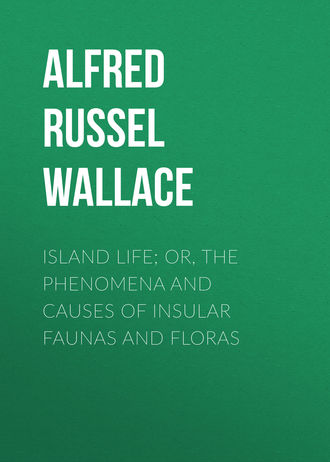 полная версия
полная версияIsland Life; Or, The Phenomena and Causes of Insular Faunas and Floras
South Temperate America as Illustrating the Influence of Astronomical Causes on Climate.—Those persons who still doubt the effect of winter in aphelion with a high degree of excentricity in producing glaciation, should consider how the condition of south temperate America at the present day is explicable if they reject this agency. The line of perpetual snow in the Southern Andes is so low as 6,000 feet in the same latitude as the Pyrenees; in the latitude of the Swiss Alps mountains only 6,200 feet high produce immense glaciers which descend to the sea-level; while in the latitude of Cumberland mountains only from 3,000 to 4,000 feet high have every valley filled with streams of ice descending to the sea-coast and giving off abundance of huge icebergs.53 Here we have exactly the condition of things to which England and Western Europe were subjected during the latter portion of the glacial epoch, when every valley in Wales, Cumberland, and Scotland had its glacier; and to what can this state of things be imputed if not to the fact that there is now a moderate amount of excentricity, and the winter of the southern hemisphere is in aphelion? The mere geographical position of the southern extremity of America does not seem especially favourable to the production of such a state of glaciation. The land narrows from the tropics southwards and terminates altogether in about the latitude of Edinburgh; the mountains are of moderate height; while during summer the sun is three millions of miles nearer, and the heat received from it is equivalent to a rise of 20° F. as compared with the same season in the northern hemisphere. The only important differences are: the open southern ocean, the longer and colder winter, and the general low temperature caused by the south polar ice. But the great accumulation of south polar ice is itself due to the great extent of high land within the Antarctic circle acted upon by the long cold winter and furnished with moisture by the surrounding wide ocean. These conditions of high land and open ocean we know did not prevail to so great an extent in the northern hemisphere during the glacial epoch, as they do in the southern hemisphere at the present time; but the other acting cause—the long cold winter—existed in a far higher degree, owing to the excentricity being about three times as much as it is now. It is, so far as we know or are justified in believing, the only efficient cause of glaciation which was undoubtedly much more powerful at that time; and we are therefore compelled to accept it as the most probable cause of the much greater glaciation which then prevailed.
Geographical Changes, how far a Cause of Glaciation.—Messrs. Croll and Geikie have both objected to the views of Sir Charles Lyell as to the preponderating influence of the distribution of land and sea on climate; and they maintain that if the land were accumulated almost wholly in the equatorial regions, the temperature of the earth's surface as a whole would be lowered, not raised, as Sir Charles Lyell maintained. The reason given is, that the land being heated heats the air, which rises and thus gives off much of the heat to space, while the same area covered with water would retain more of the heat, and by means of currents carry it to other parts of the earth's surface. But although the mean temperature of the whole earth might be somewhat lowered by such a disposition of the land, there can be little doubt that it would render all extremes of temperature impossible, and that even during a period of high excentricity there would be no glacial epochs, and perhaps no such thing as ice anywhere produced. This would result from there being no land near the poles to retain snow, while the constant interchange of water by means of currents between the polar and tropical regions would most likely prevent ice from ever forming in the sea. On the other hand, were all the land accumulated in the polar and temperate regions there can be little doubt that a state of almost perpetual glaciation of much of the land would result, notwithstanding that the whole earth should theoretically be at a somewhat higher temperature. Two main causes would bring about this glaciation. A very large area of elevated land in high latitudes would act as a powerful condenser of the enormous quantity of vapour produced by the whole of the equatorial and much of the temperate regions being areas of evaporation, and thus a greater accumulation of snow and ice would take place around both poles than would be possible under any other conditions. In the second place there would be little or no check to this accumulation of ice, because, owing to the quantity of land around the polar areas, warm oceanic currents could not reach them, while the warm winds would necessarily bring so much moisture that they would help on instead of checking the process of ice-accumulation. If we suppose the continents to be of the same total area and to have the same extent and altitude of mountain ranges as the present ones, these mountains must necessarily offer an almost continuous barrier to the vapour-bearing winds from the south, and the result would probably be that three-fourths of the land would be in the ice-clad condition of Greenland, while a comparatively narrow belt of the more southern lowlands would alone afford habitable surfaces or produce any woody vegetation.
Notwithstanding, therefore, the criticism above referred to, I believe that Sir Charles Lyell was substantially right, and that the two ideal maps given in the Principles of Geology (11th ed. Vol. i. p. 270), if somewhat modified so as to allow a freer passage of currents in the tropics, do really exhibit a condition of the earth which, by geographical changes alone, would bring about a perpetual summer or an almost universal winter. But we have seen in our sixth chapter that there is the strongest cumulative evidence, almost amounting to demonstration, that for all known geological periods our continents and oceans have occupied the same general position they do now, and that no such radical changes in the distribution of sea and land as imagined by way of hypothesis by Sir Charles Lyell, have ever occurred. Such an hypothesis, however, is not without its use in our present inquiry, for if we obtain thereby a clear conception of the influence of such great changes on climate, we are the better able to appreciate the tendency of lesser changes such as have undoubtedly often occurred.
Land as a Barrier to Ocean Currents.—We have seen already the great importance of elevated land to serve as condensers and ice-accumulators; but there is another and hardly less important effect that may be produced by an extension of land in high latitudes, which is, to act as a barrier to the flow of ocean currents. In the region with which we are more immediately interested it is easy to see how a comparatively slight alteration of land and sea, such as has undoubtedly occurred, would produce an enormous effect on climate. Let us suppose, for instance, that the British Isles again became continental, and that this continental land extended across the Färoe Islands and Iceland to Greenland. The whole of the warm waters of the Atlantic, with the Gulf Stream, would then be shut out from Northern Europe, and the result would almost certainly be that snow would accumulate on the high mountains of Scandinavia till they became glaciated to as great an extent as Greenland, and the cold thus produced would react on our own country and cover the Grampians with perpetual snow, like mountains of the same height at even a lower latitude in South America.
If a similar change were to occur on the opposite side of the Atlantic very different effects would be produced. Suppose, for instance, the east side of Greenland were to sink considerably, while on the west the sea bottom were to rise in Davis' Strait so as to unite Greenland with Baffin's Land, thus stopping altogether the cold Arctic current with its enormous stream of icebergs from the west coast of Greenland. Such a change might cause a great accumulation of ice in the higher polar latitudes, but it would certainly produce a wonderful ameliorating effect on the climate of the east coast of North America, and might raise the temperature of Labrador to that of Scotland. Now these two changes have almost certainly occurred, either together or separately, during the Tertiary period, and they must have had a considerable effect either in aiding or checking the action of the terrestrial and astronomical causes affecting climate which were then in operation.
It would be easy to suggest other probable changes which would produce a marked effect on climate; but we will only refer to the subsidence of the Isthmus of Panama, which has certainly happened more than once in Tertiary times. If this subsidence were considerable it would have allowed much of the accumulated warm water which initiates the Gulf Stream to pass into the Pacific; and if this occurred while astronomical causes were tending to bring about a cold period in the northern hemisphere, the resulting glaciation might be exceptionally severe. The effect of this change would however be neutralised if at the same epoch the Lesser and Greater Antilles formed a connected land.
Now, as such possible and even probable geographical changes are very numerous, they must have produced important effects; and though we may admit that the astronomical causes already explained were the most important in determining the last glacial epoch, we must also allow that geographical changes must often have had an equally important and perhaps even a preponderating influence on climate. We must also remember that changes of land and sea are almost always accompanied by elevation or depression of the pre-existing land: and whereas the former produces its chief effect by diverting the course of warm or cold oceanic currents, the latter is of not less importance in adding to or diminishing those areas of condensation and ice-accumulation which, as we have seen, are the most efficient agents in producing glaciation.
If then Sir Charles Lyell may have somewhat erred in attaching too exclusive an importance to geographical changes as bringing about mutations of climate, his critics have, I think, attached far too little importance to these changes. We know that they have always been in progress to a sufficient extent to produce important climatal effects; and we shall probably be nearest the truth if we consider, that great extremes of cold have only occurred when astronomical and geographical causes were acting in the same direction and thus produced a cumulative result, while, through the agency of warm oceanic currents, the latter alone have been the chief cause of mild climates in high latitudes, as we shall attempt to prove in our next chapter.54
On the Theory of Inter-glacial Periods and their Probable Character.—The theory by which the glacial epoch is here explained is one which apparently necessitates repeated changes from glacial to warm periods, with all the consequences and modifications both of climate and physical geography which follow or accompany such changes. It is essentially a theory of alternation; and it is certainly remarkable in how many cases geologists have independently deduced some alternations of climate as probable. Such are the interglacial deposits indicating a mild climate, both in Europe and America; an early phase of very severe glaciation when the "till" was deposited, with later less extensive glaciation when moraines were left in the valleys; several successive periods of submergence and elevation, the later ones becoming less and less in amount, as indicated by the raised beaches slightly elevated above our present coast line; and lastly, the occurrence in the same deposits of animal remains indicating both a warm and a cold climate, and especially the existence of the hippopotamus in Yorkshire not long after the period of extreme glaciation.
But although the evidence of some alternations of climate seems indisputable, and no suggestion of any adequate cause for them other than the alternating phases of precession during high excentricity has been made, it by no means follows that these changes were always very great—that is to say, that the ice completely disappeared and a warm climate prevailed throughout the whole year. It is quite evident that during the height of the glacial epoch there was a combination of causes at work which led to a large portion of North-western Europe and Eastern America being buried in ice to a greater extent even than Greenland is now, since it certainly extended beyond the land and filled up all the shallow seas between our islands and Scandinavia. Among these causes we must reckon a diminution of the force of the Gulf Stream, or its being diverted from the north-western coasts of Europe; and what we have to consider is, whether the alteration from a long cold winter and short hot summer to a short mild winter and long cool summer would greatly affect the amount of ice if the ocean currents remained the same. The force of these currents is, it is true, by our hypothesis, modified by the increase or diminution of the ice in the two hemispheres alternately, and they then react upon climate; but they cannot be thus changed till after the ice-accumulation has been considerably affected by other causes. Their direction may, indeed, be greatly changed by slight alterations in the outline of the land, while they may be barred out altogether by other alterations of not very great amount; but such changes as these have no relation to the alteration of climates caused by the changing phases of precession.
Now, the existence at the present time of an ice-clad Greenland is an anomaly in the northern hemisphere, only to be explained by the fact that cold currents from the polar area flow down both sides of it. In Eastern Asia we have the lofty Stanivoi Mountains in the same latitude as the southern part of Greenland, which, though their summits are covered with perpetual snow, give rise to no ice-sheet, and, apparently, even to no important glaciers;—a fact undoubtedly connected with the warm Japan current flowing partially into the Sea of Okhotsk. So in North-west America we have the lofty coast range, culminating in Mt. St. Elias, nearly 15,000 feet high, and an extensive tract of high land to the north and north-west, with glaciers comparable in size with those of New Zealand, although situated in Lat. 60° instead of in Lat. 45°. Here, too, we have the main body of the Japan current turning east and south, and thus producing a mild climate, little inferior to that of Norway, warmed by the Gulf Stream. We thus have it made clear that could the two Arctic currents be diverted from Greenland, that country would become free from ice, and might even be completely forest-clad and inhabitable; while, if the Japan current were to be diverted from the coast of North America and a cold current come out of Behring's Strait, the entire northwestern extremity of America would even now become buried in ice.
Now it is the opinion of the best American geologists that during the height of the glacial epoch North-eastern America was considerably elevated.55 This elevation would bring the wide area of the banks of Newfoundland far above water, causing the American coast to stretch out in an immense curve to a point more than 600 miles east of Halifax; and this would certainly divert much of the greatly reduced Gulf Stream straight across to the coast of Spain. The consequence of such a state of things would probably be that the southward flowing Arctic currents would be much reduced in velocity; and the enormous quantity of icebergs continually produced by the ice-sheets of all the lands bordering the North Atlantic would hang about their shores and the adjacent seas, filling them with a dense ice-pack, equalling that of the Antarctic regions, and chilling the atmosphere so as to produce constant clouds and fog with almost perpetual snowstorms, even at midsummer, such as now prevail in the worst portions of the Southern Ocean.
But when such was the state of the North Atlantic (and, however caused, such must have been its state during the height of the glacial epoch), can we suppose that the mere change from the distant sun in winter and near sun in summer, to the reverse, could bring about any important alteration—the physical and geographical causes of glaciation remaining unchanged? For, certainly, the less powerful sun of summer, even though lasting somewhat longer, could not do more than the much more powerful sun did during the phase of summer in perihelion, while during the less severe winters the sun would have far less power than when it was equally near and at a very much greater altitude in summer. It seems to me, therefore, quite certain that whenever extreme glaciation has been brought about by high excentricity combined with favourable geographical and physical causes (and without this combination it is doubtful whether extreme glaciation would ever occur), then the ice-sheet will not be removed during the alternate phases of precession, so long as these geographical and physical causes remain unaltered. It is true that the warm and cold oceanic currents, which are the most important agents in increasing or diminishing glaciation, depend for their strength and efficiency upon the comparative extents of the northern and southern ice-sheets; but these ice-sheets cannot, I believe, increase or diminish to any important extent unless some geographical or physical change first occurs.56
If this argument is valid, then it would follow that, so long as excentricity was high, whatever condition of climate was brought about by it in combination with geographical causes, would persist through several phases of precession; but this would not necessarily be the case when the excentricity itself changed, and became more moderate. It would then depend upon the proportionate effect of climatal and geographical causes in producing glaciation as to what change would be produced by the changing phases of precession; and we can best examine this question by considering the probable effect of the change in precession during the next period of 10,500 years, with the present moderate degree of excentricity.
Probable Effect of Winter in Aphelion on the Climate of Britain.—Let us then suppose the winters of the northern hemisphere to become longer and much colder, the summers being proportionately shorter and hotter, without any other change whatever. The long cold winter would certainly bring down the snow-line considerably, covering large areas of high land with snow during the winter months, and causing all glaciers and ice-fields to become larger. This would chill the superincumbent atmosphere to such an extent that the warm sun and winds of spring and early summer would bring clouds and fog, so that the sun-heat would be cut off and much vapour be condensed as snow. The greater sun-heat of summer would no doubt considerably reduce the snow and ice; but it is, I think, quite certain that the extra accumulation would not be all melted, and that therefore the snow-line would be permanently lowered. This would be a necessary result, because the greater part of the increased cold of winter would be stored up in snow and ice, while the increased heat of summer could not be in any way stored up, but would be largely prevented from producing any effect, by reflection from the surface of the snow and by the intervention of clouds and fog which would carry much of the heat they received to other regions. It follows that 10,000 years hence, when our winter will occur in aphelion (instead of, as now, in perihelion), there will be produced a colder climate, independently of any change of land and sea, of heights of mountains, or in the force of oceanic currents.
But if this is true, then the reverse change, bringing the sun back into exactly the same position with regard to us as it is in now (all geographical and physical conditions remaining unchanged), would certainly bring back again our present milder climate. The change either way would not probably be very great, but it might be sufficient to bring the snow-line down to 3,000 feet in Scotland, so that all the higher mountains would have their tops covered with perpetual snow. This perpetual snow, down to a fixed line, would be kept up by the needful supply of snow falling during autumn, winter, and spring, and this would, as we have seen, depend mainly on the increased length and greatly increased cold of the winter. As both the duration and the cold of winter decreased the amount of snow would certainly decrease, and of this lesser quantity of snow a larger proportion would be melted by the longer, though somewhat cooler summer. This would follow because the total amount of sun-heat received during the summer would be the same as before, while it would act on a less quantity of snow; there would thus be a smaller surface to reflect the heat, and a smaller condensing area to produce fogs, while the diminished intensity of the sun would produce a less dense canopy of clouds, which have been shown to be of prime importance in checking the melting of snow by the sun. We have considered this case, for simplicity of reasoning, on the supposition that all geographical and physical causes remained unchanged. But if an alteration of the climate of the whole north temperate and Arctic zones occurred, as here indicated, this would certainly affect both the winds and currents, in the manner already explained (see p. 142), so as to react upon climate and increase the differences produced by phases of precession. How far that effect would be again increased by corresponding but opposite changes in the southern hemisphere it is impossible to say. It may be that existing geographical and physical conditions are there such potent agents in producing a state of glaciation that no change in the phases of precession would materially affect it. Still, as the climate of the whole southern hemisphere is dominated by the great mass of ice within the Antarctic circle, it seems probable that if the winter were shorter and the summer longer the quantity of ice would slightly diminish; and this would again react on the northern climate as already fully explained.
The Essential Principle of Climatal Change Restated.—The preceding discussion has been somewhat lengthy, owing to the varied nature of the facts and arguments adduced, and the extreme complexity of the subject. But if, as I venture to urge, the principle here laid down is a sound one, it will be of the greatest assistance in clearing away some of the many difficulties that beset the whole question of geological climates. This principle is, briefly, that the great features of climate are determined by a combination of causes, of which geographical conditions and the degree of excentricity of the earth's orbit are by far the most important; that, when these combine to produce a severe glacial epoch, the changing phases of precession every 10,500 years have very little, if any, effect on the character of the climate, as mild or glacial, though it may modify the seasons; but when the excentricity becomes moderate and the resulting glaciation less severe, then the changing phases of precession bring about a considerable alteration, and even a partial reversal of the glacial conditions.
The reason of this may perhaps be made clearer by considering the stability of either extreme glacial conditions or the entire absence of perpetual ice and snow, and the comparative instability of an intermediate state of climate. When a country is largely covered with ice, we may look upon it as possessing the accumulated or stored-up cold of a long series of preceding winters; and however much heat is poured upon it, its temperature cannot be raised above the freezing point till that store of cold is got rid of—that is, till the ice is all melted. But the ice itself, when extensive, tends to its own preservation, even under the influence of heat; for the chilled atmosphere becomes filled with fog, and this keeps off the sun-heat, and then snow falls even during summer, and the stored-up cold does not diminish during the year. When, however, only a small portion of the surface is covered with ice, the exposed earth becomes heated by the hot sun, this warms the air, and the warm air melts the adjacent ice. It follows, that towards the equatorial limits of a glaciated country alternations of climate may occur during a period of high excentricity, while nearer the pole, where the surface is almost completely ice-clad, no amelioration may take place. The same argument will, to some extent apply, inversely, with mild Arctic climates; but this is a subject which will be discussed in the next chapter.









